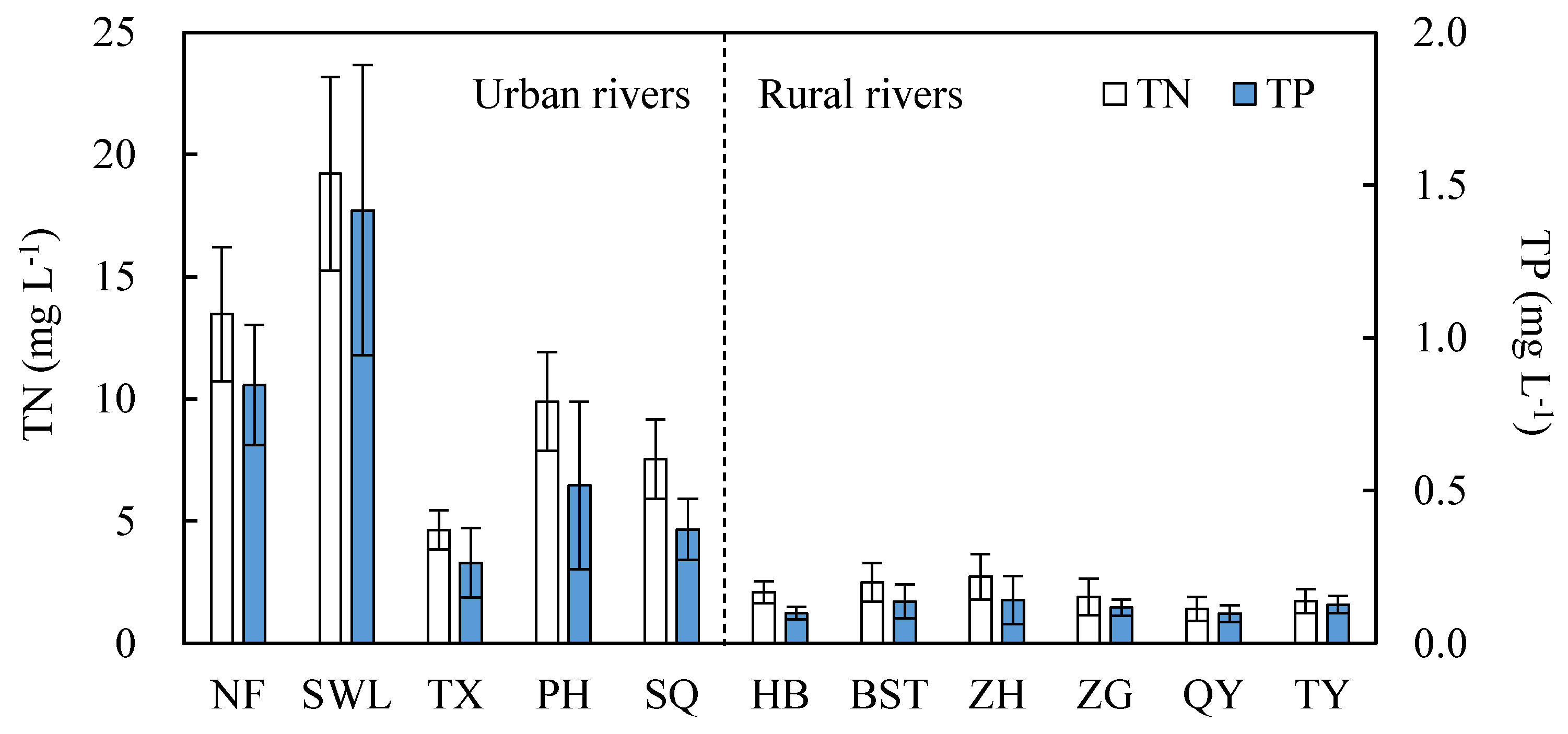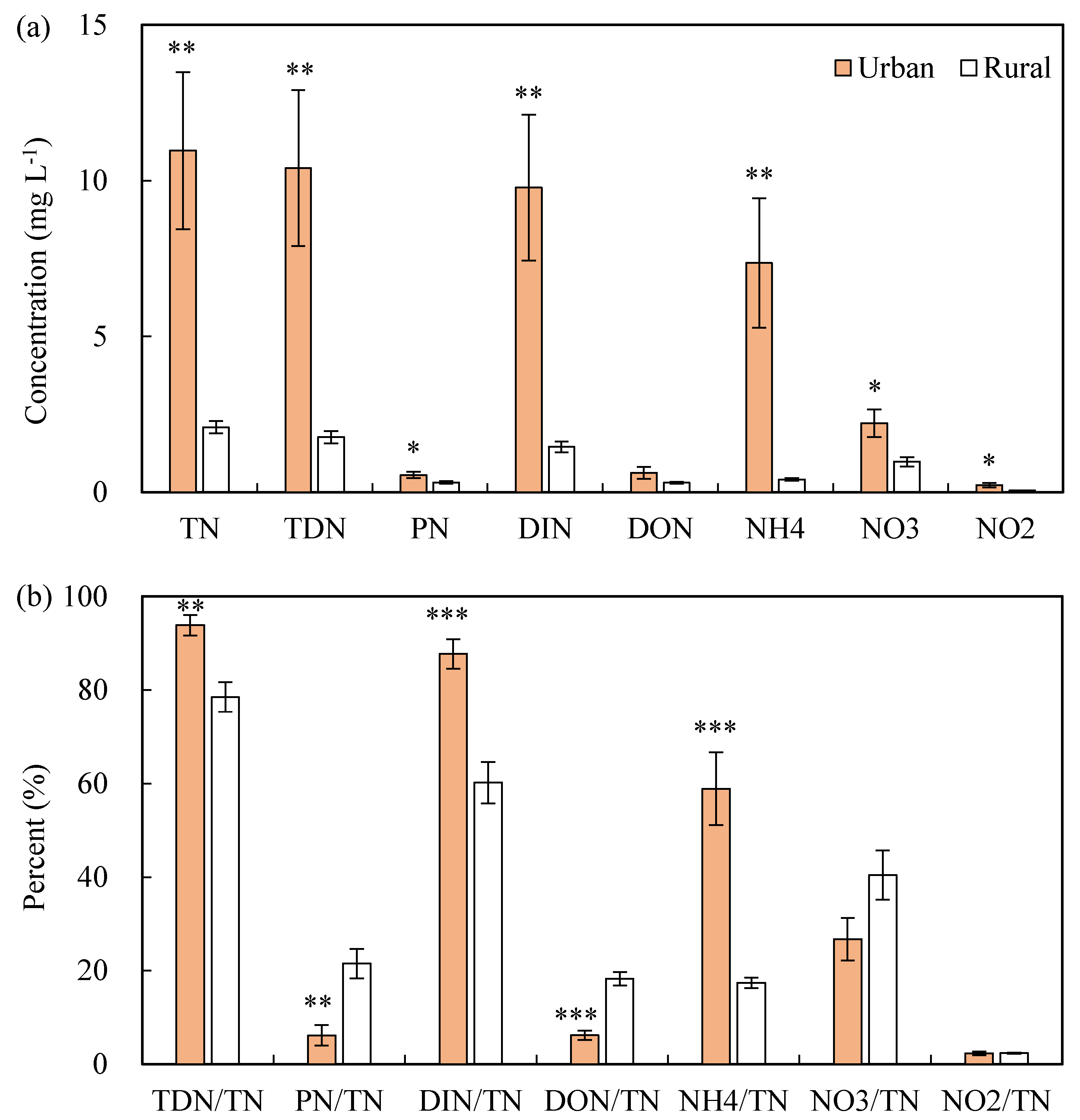Forms of Nutrients in Rivers Flowing into Lake Chaohu: A Comparison between Urban and Rural Rivers
Abstract
:1. Introduction

2. Materials and Methods
2.1. Field Sampling
2.2. Analyses of Water Samples
2.3. Analyses of Sediment Cores
2.4. Statistical Analysis
3. Results
3.1. General Results
| Group | River (Abbreviation) | Water Depth (m) | Water Temperature (°C) | DO (mg·L−1) | pH | ||||||||
| Mean | Min | Max | Mean | Min | Max | Mean | Min | Max | Mean | Min | Max | ||
| Urban | Nanfei River (NF) | 3.1 | 2.8 | 3.5 | 18.3 | 9.2 | 24.9 | 4.1 | 3.2 | 4.9 | 7.53 | 7.46 | 7.56 |
| Shiwuli River (SWL) | 2.2 | 1.9 | 2.5 | 18.1 | 9.3 | 25.0 | 1.6 | 0.8 | 2.5 | 7.61 | 7.36 | 7.75 | |
| Tangxi River (TX) | 2.2 | 2.0 | 2.3 | 17.7 | 9.3 | 24.2 | 7.4 | 6.6 | 8.7 | 7.54 | 7.28 | 7.69 | |
| Paihe River (PH) | 4.1 | 3.1 | 4.6 | 17.7 | 10.2 | 22.8 | 3.5 | 1.8 | 7.5 | 7.45 | 7.17 | 7.60 | |
| Shuangqiao River (SQ) | 2.5 | 1.7 | 3.4 | 18.3 | 10.8 | 24.2 | 2.1 | 1.5 | 2.8 | 7.55 | 7.19 | 7.97 | |
| Rural | Hangbu River (HB) | 3.7 | 3.4 | 3.9 | 18.0 | 9.7 | 23.3 | 9.1 | 7.8 | 9.9 | 7.50 | 7.22 | 7.76 |
| Baishitian River (BST) | 4.0 | 3.5 | 4.5 | 17.9 | 9.4 | 23.9 | 7.8 | 7.1 | 8.6 | 7.46 | 7.09 | 7.80 | |
| Zhaohe River (ZH) | 3.1 | 2.4 | 3.5 | 18.0 | 10.1 | 23.8 | 7.4 | 6.7 | 8.0 | 7.47 | 7.04 | 7.76 | |
| Zhegao River (ZG) | 4.3 | 4.1 | 4.5 | 18.3 | 10.8 | 24.7 | 7.5 | 6.8 | 8.5 | 7.55 | 7.30 | 7.72 | |
| Qiyang River (QY) | 1.8 | 1.6 | 2.0 | 18.3 | 10.6 | 25.1 | 7.1 | 6.4 | 8.1 | 7.60 | 7.32 | 7.88 | |
| Tongyang River (TY) | 1.8 | 1.2 | 2.2 | 18.5 | 10.4 | 25.0 | 7.3 | 5.9 | 8.1 | 7.48 | 7.31 | 7.72 | |



3.2. Composition of P and N in Water
3.3. P and N in Sediments


4. Discussion
5. Conclusions
Supplementary Files
Supplementary File 1Acknowledgments
Author Contributions
Conflicts of Interest
References
- Heisler, J.; Glibert, P.; Burkholder, J.M.; Anderson, D.; Cochlan, W.; Dennison, W.; Dortch, Q.; Gobler, C.; Heil, C.; Humphries, E. Eutrophication and harmful algal blooms: A scientific consensus. Harmful Algae 2008, 8, 3–13. [Google Scholar] [CrossRef]
- Smith, V.H.; Schindler, D.W. Eutrophication science: Where do we go from here? Trends Ecol. Evol. 2009, 24, 201–207. [Google Scholar] [CrossRef] [PubMed]
- Paerl, H.W.; Fulton, R.S.; Moisander, P.H.; Dyble, J. Harmful freshwater algal blooms, with an emphasis on cyanobacteria. Sci. World J. 2001, 1, 76–113. [Google Scholar] [CrossRef] [PubMed]
- Anderson, D.M.; Cembella, A.D.; Hallegraeff, G.M. Progress in understanding harmful algal blooms: Paradigm shifts and new technologies for research, monitoring, and management. Ann. Rev. Mar. Sci. 2012, 4, 143–176. [Google Scholar] [CrossRef] [PubMed]
- Conley, D.J.; Paerl, H.W.; Howarth, R.W.; Boesch, D.F.; Seitzinger, S.P.; Havens, K.E.; Lancelot, C.; Likens, G.E. Controlling eutrophication: Nitrogen and phosphorus. Science 2009, 323, 1014–1015. [Google Scholar] [CrossRef] [PubMed]
- Qin, B.; Xu, H.; Dong, B. The Principle and Practice of Eutrophic Lake Restoration and Management; Higher Education Press: Beijing, China, 2011. [Google Scholar]
- Paerl, H.W.; Gardner, W.S.; McCarthy, M.J.; Peierls, B.L.; Wilhelm, S.W. Algal blooms: Noteworthy nitrogen. Science 2014, 346. [Google Scholar] [CrossRef] [PubMed]
- Howarth, R.; Sharpley, A.; Walker, D. Sources of nutrient pollution to coastal waters in the United States: Implications for achieving coastal water quality goals. Estuaries 2002, 25, 656–676. [Google Scholar] [CrossRef]
- Yu, Y.; Wu, J.; Wang, X.Y.; Zhang, Z.M. Degradation of inorganic nitrogen in Beiyun River of Beijing, China. Procedia Environ. Sci. 2012, 13, 1069–1075. [Google Scholar] [CrossRef]
- Mao, G.; Yang, L.; Yan, W.; Lei, K. The influence of pollutant inputs from the major tributaries on water quality of Chaohu Lake. J. Agro Environ. Sci. 2014, 33, 141–147. [Google Scholar]
- Paul, M.J.; Meyer, J.L. Streams in the Urban Landscape. In Urban Ecology; Marzluff, J.M., Shulenberger, E., Endlicher, W., Alberti, M., Bradley, G., Ryan, C., Simon, U., ZumBrunnen, C., Eds.; Springer: New York, NY, USA, 2008. [Google Scholar]
- Zhou, T. The Role of Nitrogen in Bloom Formation and Maintenance of Lake Taihu. Master’s Thesis, Nanjing University, Nanjing, China, 26 May 2013. [Google Scholar]
- Mackey, K.R.M.; Labiosa, R.G.; Calhoun, M.; Street, J.H.; Post, A.F.; Paytan, A. Phosphorus availability, phytoplankton community dynamics, and taxon-specific phosphorus status in the Gulf of Aqaba, Red Sea. Limnol. Oceanogr. 2007, 52, 873–885. [Google Scholar] [CrossRef]
- Dai, G.; Shang, J.; Qiu, B. Ammonia may play an important role in the succession of cyanobacterial blooms and the distribution of common algal species in shallow freshwater lakes. Glob. Ch. Biol. 2012, 18, 1571–1581. [Google Scholar] [CrossRef]
- McCarthy, M.J.; James, R.T.; Chen, Y.; East, T.L.; Gardner, W.S. Nutrient ratios and phytoplankton community structure in the large, shallow, eutrophic, subtropical Lakes Okeechobee (Florida, USA) and Taihu (China). Limnology 2009, 10, 215–227. [Google Scholar] [CrossRef]
- Wang, S.; Dou, H. Biography of Lakes in China; Science Press: Beijing, China, 1998. [Google Scholar]
- Xie, P. Reading about the Histories of Cyanobacteria, Eutrophication and Geological Evolution in Lake Chaohu; Science Press: Beijing, China, 2009. [Google Scholar]
- Yang, L.; Lei, K.; Meng, W.; Fu, G.; Yan, W. Temporal and spatial changes in nutrients and chlorophyll-α in a shallow lake, Lake Chaohu, China: An 11-year investigation. J. Environ. Sci. 2013, 25, 1117–1123. [Google Scholar] [CrossRef]
- Hefei Municipal Bureau of Statistics. 3–8 Urban Population of Hefei City (2013). Available online: http://tjj.hefei.gov.cn/n7216006/n9376603/n9377097/n9377118/n36794982/36834889.html (accessed on 8 August 2015). (In Chinese)
- Hefei Municipal Bureau of Statistics. 3–9 Populations of Four Counties and One County-Level City in Hefei City (2013). Available online: http://tjj.hefei.gov.cn/n7216006/n9376603/n9377097/n9377118/n36794982/36834924.html (accessed on 8 August 2015). (In Chinese)
- Wu, L. Analysis on land-use change and ecosystem function value for the Chaohu Lake basin during past 20 years. Soils 2009, 41, 986–991. [Google Scholar]
- Chinese EPA. Methods for the Examination of Water and Wastewater, 4th ed.; China Environmental Science Press: Beijing, China, 2002. [Google Scholar]
- Worsfold, P.J.; Monbet, P.; Tappin, A.D.; Fitzsimons, M.F.; Stiles, D.A.; McKelvie, I.D. Characterisation and quantification of organic phosphorus and organic nitrogen components in aquatic systems: A review. Anal. Chim. Acta 2008, 624, 37–58. [Google Scholar] [CrossRef] [PubMed]
- Lukkari, K.; Hartikainen, H.; Leivuori, M. Fractionation of sediment phosphorus revisited: I Fractionation steps and their biogeochemical basis. Limnol. Oceanogr. Meth. 2007, 5, 433–444. [Google Scholar] [CrossRef]
- Rydin, E. Potentially mobile phosphorus in Lake Erken sediment. Water Res. 2000, 34, 2037–2042. [Google Scholar] [CrossRef]
- Ruban, V.; López-Sánchez, J.; Pardo, P.; Rauret, G.; Muntau, H.; Quevauviller, P. Selection and evaluation of sequential extraction procedures for the determination of phosphorus forms in lake sediment. J. Environ. Monit. 1999, 1, 51–56. [Google Scholar] [CrossRef] [PubMed]
- Wang, S.; Jiang, X.; Jin, X. Classification and pollution characteristic analysis for inflow rivers of Chaohu Lake. Environ. Sci. 2011, 32, 2834–2839. [Google Scholar]
- Ji, L.; Li, J.; Wang, J. Research on water environmental capacity in Nanfeihe River in Hefei city. J. Anhui Univ. Nat. Sci. 2004, 28, 71–75. [Google Scholar]
- Dueñas, J.F.; Alonso, J.R.; Rey, À.F.; Ferrer, A.S. Characterisation of phosphorous forms in wastewater treatment plants. J. Hazard. Mater. 2003, 97, 193–205. [Google Scholar] [CrossRef]
- Jarvie, H.P.; Neal, C.; Withers, P.J.A. Sewage-effluent phosphorus: A greater risk to river eutrophication than agricultural phosphorus? Sci. Total Environ. 2006, 360, 246–253. [Google Scholar] [CrossRef] [PubMed]
- Neal, C.; Martin, E.; Neal, M.; Hallett, J.; Wickham, H.D.; Harman, S.A.; Armstrong, L.K.; Bowes, M.J.; Wade, A.J.; Keay, D. Sewage effluent clean-up reduces phosphorus but not phytoplankton in lowland chalk stream (River Kennet, UK) impacted by water mixing from adjacent canal. Sci. Total Environ. 2010, 408, 5305–5316. [Google Scholar] [CrossRef] [PubMed]
- Uusitalo, R.; Turtola, E.; Kauppila, T.; Lilja, T. Particulate phosphorus and sediment in surface runoff and drainflow from clayey soils. J. Environ. Qual. 2001, 30, 589–595. [Google Scholar] [CrossRef] [PubMed]
- Zhang, L.; Liao, Q.; Zeng, C.; Mo, Q.; Fan, C. Effects of pretreatment on the sequential phosphorus fractionation of anaerobic sediment. J. Limnol. 2014, 73, 274–281. [Google Scholar] [CrossRef]
- Zhu, G.; Zhang, L. Phosphorus fractions and algae availability in sediment from lakes in the middle and lower reaches of the Yangtze River. Sci. China Ser. D 2005, 35, 24–32. [Google Scholar]
- Wang, X.; Wang, X.; Feng, Y.; Xue, J. Study on content of total phosphorus and forms of inorganic phosphorus in sediments of Chaohu Lake. J. Soil Water Conserv. 2007, 21, 56–59. [Google Scholar]
- Jensen, H.S.; Thamdrup, B. Iron-bound phosphorus in marine sediments as measured by bicarbonate-dithionite extraction. Hydrobiologia 1993, 253, 47–59. [Google Scholar] [CrossRef]
- Meis, S.; Spears, B.M.; Maberly, S.C.; O’Malley, M.B.; Perkins, R.G. Sediment amendment with Phoslock® in Clatto Reservoir (Dundee, UK): Investigating changes in sediment elemental composition and phosphorus fractionation. J. Environ. Manag. 2012, 93, 185–193. [Google Scholar] [CrossRef] [PubMed]
- Liu, S.; Kong, F.; Cai, Y.; Yang, Z.; Wang, J.; Shi, X. Nitrogen stable isotope study on nitrate nitrogen pollution of four inflowing rivers of Lake Chaohu. J. Lake Sci. 2012, 24, 952–956. [Google Scholar]
- Zhao, Y.; Shan, B.; Zhang, W.; Wang, C. Forms and spatial distribution characteristics of nitrogen in Ziya River basin. Environ. Sci. 2014, 35, 143–149. [Google Scholar]
- Jiang, Y.J.; He, W.; Liu, W.X.; Qin, N.; Ouyang, H.L.; Wang, Q.M.; Kong, X.Z.; He, Q.S.; Yang, C.; Yang, B.; et al. The seasonal and spatial variations of phytoplankton community and their correlation with environmental factors in a large eutrophic Chinese lake (Lake Chaohu). Ecol. Indic. 2014, 40, 58–67. [Google Scholar] [CrossRef]
© 2015 by the authors; licensee MDPI, Basel, Switzerland. This article is an open access article distributed under the terms and conditions of the Creative Commons Attribution license (http://creativecommons.org/licenses/by/4.0/).
Share and Cite
Zhang, L.; Shao, S.; Liu, C.; Xu, T.; Fan, C. Forms of Nutrients in Rivers Flowing into Lake Chaohu: A Comparison between Urban and Rural Rivers. Water 2015, 7, 4523-4536. https://doi.org/10.3390/w7084523
Zhang L, Shao S, Liu C, Xu T, Fan C. Forms of Nutrients in Rivers Flowing into Lake Chaohu: A Comparison between Urban and Rural Rivers. Water. 2015; 7(8):4523-4536. https://doi.org/10.3390/w7084523
Chicago/Turabian StyleZhang, Lei, Shiguang Shao, Cheng Liu, Tingting Xu, and Chengxin Fan. 2015. "Forms of Nutrients in Rivers Flowing into Lake Chaohu: A Comparison between Urban and Rural Rivers" Water 7, no. 8: 4523-4536. https://doi.org/10.3390/w7084523
APA StyleZhang, L., Shao, S., Liu, C., Xu, T., & Fan, C. (2015). Forms of Nutrients in Rivers Flowing into Lake Chaohu: A Comparison between Urban and Rural Rivers. Water, 7(8), 4523-4536. https://doi.org/10.3390/w7084523





